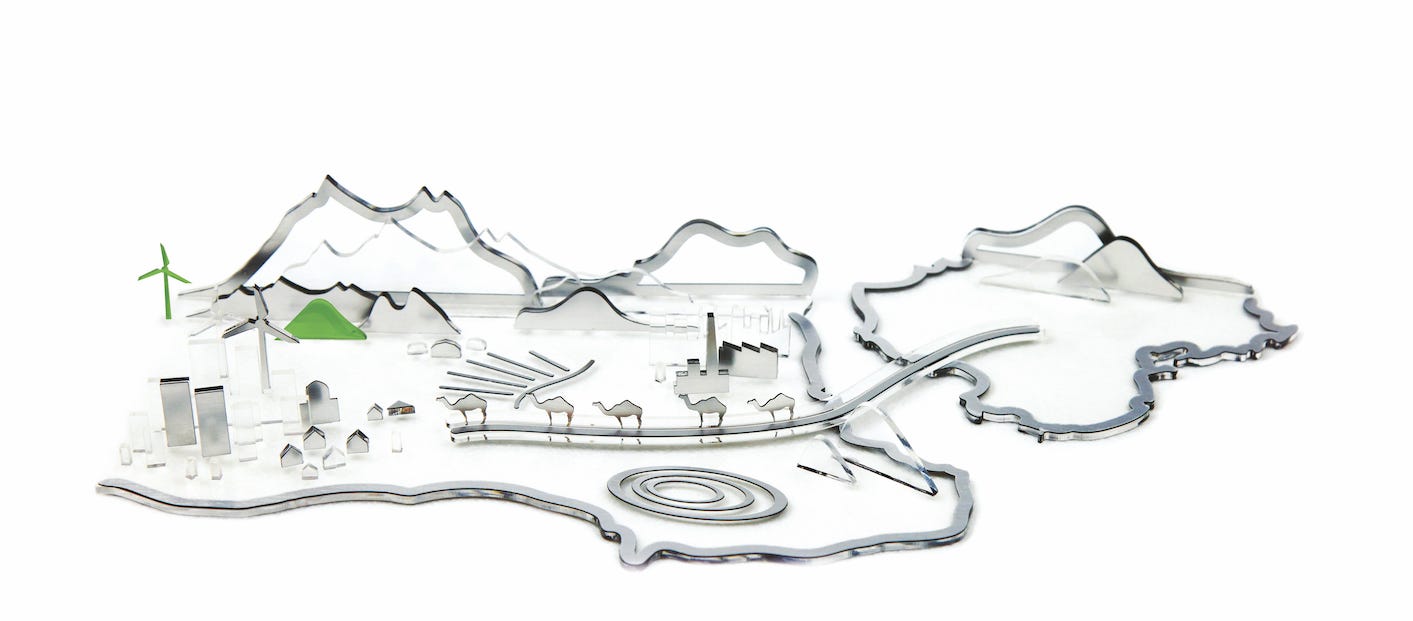#31: How a ‘Smaller and Greener’ BRI Could Leave Vulnerable Mountain Communities Behind
China’s Belt and Road initiative has improved connectivity in the world’s mountain regions. To continuously boost climate resiliency, infrastructure finance is key.
In this week’s newsletter, Dr. Otto Simonett from Zoï Environment Network shares his thoughts on infrastructure connectivity and climate resilience in mountain areas.
With a career spanning roles at the nonprofit environmental communication center GRID-Arendal and the United Nations Environment Programme in Europe and Africa, Otto co-founded Zoï 16 years ago to make environmental information accessible and compelling for decision-makers and the public.
I first encountered Zoï a few years ago at a UN conference on the Belt and Road Initiative (BRI). There, Otto introduced me to the concept of environmental and social safeguards, a pragmatic approach that functions less as an aspirational best practice and more as a crucial safety net. Acting as a shield, these safeguards help to balance urgent infrastructure needs with long-term sustainability.
Infrastructure connectivity through roads and railways facilitates access to essential services like healthcare and education, which are critical for adapting to climate change and building resilience, particularly in the world’s most vulnerable mountain communities. Meanwhile, BRI infrastructure projects have long faced criticism for contributing to debt crises, ecological degradation, and inadequate engagement with local communities, as extensively documented by researchers and institutions.
Over the past decade, sustained engagement from activists and advocacy groups has pushed Chinese development banks, corporations, and industry associations to gradually – though imperfectly – integrate environmental and social policies into their practices. China is also increasingly embracing the “small yet beautiful” approach in future BRI projects, shifting away from large-scale infrastructure projects. While this transition serves China’s strategic interests and contributes to global climate action, its gradual retreat is widening an already substantial funding gap.
I hope you enjoy this newsletter. Let us know what you think in the comments. If you’d like to write for us, drop us an email at contact@shuangtan.me.

Essay: How a ‘Smaller and Greener’ BRI Could Leave Vulnerable Mountain Communities Behind
China’s Belt and Road initiative has improved connectivity in the world’s mountain regions. To continuously boost climate resiliency, infrastructure finance is key.
By Dr. Otto Simonett
Edited by Hongqiao Liu and Kevin Schoenmakers
Every summer, I escape Geneva and retreat to the serene mountains of Grisons in eastern Switzerland, better known to the world as the site of the Davos World Economic Forum. There, my brother and I share an old cabin perched on a ridge overlooking the Schams Valley. This cabin, worn by 100 years of sunshine, snow, and storms, including the mountains’ Foehn winds, has become my sanctuary.
Reaching this remote hideaway is easier than you’d expect. Switzerland’s efficient public transportation allows me to blend into the wilderness within a few hours. Isolated, my days are spent reading, hiking, cooking meals on the wood-fired stove, and reconnecting with nature. But modern conveniences are never far: we have clean water, stable electricity, and a smart webcam that provides live weather conditions and forecasts.
But mountainous areas in many other countries aren’t so lucky. All together, the globe’s mountains are home to over a billion people and provide vital resources – such as freshwater, biodiversity, and recreation – for billions more downstream. However, their remoteness and limited access to markets and services often leave local mountain communities facing higher poverty rates and slower development compared to lowland areas.
China’s Belt-and-Road Initiative, the BRI, started some 12 years ago and provided severely needed funding for infrastructure projects in mountainous areas. These include a highway connecting Montenegro with Serbia, and a highway connecting Central Asia’s Fergana Valley – shared by Uzbekistan, Kyrgyzstan, and Tajikistan – with China. Given mountain regions’ compounded challenges, the countries embraced these developments with general enthusiasm.
Support Shuang Tan
Shuang Tan is an independent initiative dedicated to tracking China’s energy transition and decarbonization. The newsletter is curated, written, and edited by Hongqiao Liu, with additional editing by Kevin Schoenmakers.
The benefits of these projects can be transformative: reduced travel times, expanded cargo capacities, improved access to essential services, and more trade and other economic opportunities. Better and modern infrastructure also reduces disruptions from natural disasters, can contribute to more efficient energy use, and provide alternative income sources such as tourism. In the last decade, BRI projects improved the transportation networks in several mountain regions of the world.
But these projects came with environmental concerns. Since 2009, my team at the Zoï Environment Network, a nonprofit dedicated to making environmental information appealing and accessible, has focused on enhancing awareness of climate and environmental issues across the world’s mountainous regions. These areas are on the front lines of climate change, with accelerated warming, glacier retreat, and more frequent natural disasters.
Ensuring the environmental safety and sustainability of large-scale infrastructure is critical. Thoughtful planning can help avoid the risks of long-term debt and stranded assets and manage the environmental footprint associated with construction and operation.
Infrastructure project development in mountain regions, with their sensitive ecosystems and implications for downstream regions, requires high environmental scrutiny. The planned Uzbekistan-Kyrgyzstan-China highway will cross the Mountains of Central Asia biodiversity hotspot at high elevations of 2,500-3,000 meters. At this altitude, climate change has already impacted the mountain permafrost, rock, and soil stability and the safety of mines. The almost completed new strategic North-South road in Kyrgyzstan is essential for ensuring connectivity and economic security in parts of the country. But it may also bring more and new environmental pressures to the fragile mountain ecosystems.
Ensuring the environmental safety and sustainability of large-scale infrastructure is critical. Thoughtful planning can help avoid the risks of long-term debt and stranded assets and manage the environmental footprint associated with construction and operation. For instance, the above-mentioned China-built highway in Montenegro for the time being leads to “nowhere,” waiting for a missing bit connecting it to Serbia. And, the existing construction has already damaged parts of the UNESCO-protected Tara river banks. Better coordination between the countries and taking into account basic environmental safeguards could have prevented the current situation.
Applying robust safeguards, and implementing climate-resilient – or “climate-proof” – approaches can protect both the environment and local economies. This involves integrating climate impact scenarios into the planning and design of roads, railways, and other infrastructure.
While these practices are standard in some regions and are used by the international development banks, they are often overlooked in remote mountain areas, where climate considerations, transparency, and community concerns are less integrated into planning. Mountain regions have more complex climates and higher natural disaster risks than lowland areas, and their communities are not of primary concern to decision makers.
With the BRI, an important funding source for infrastructure projects in developing countries, pivoting toward supporting smaller, greener, and “beautiful” projects like clean technology, the substantial financing gap further widened.
With the BRI, an important funding source for infrastructure projects in developing countries, pivoting toward supporting smaller, greener, and “beautiful” projects like clean technology, the substantial financing gap further widened. In the 12 years of its existence, cumulative BRI investment in infrastructure was $679 billion world-wide. But annual spending had already started to decline in 2017. It is unknown who may fill this investment gap, in particular in remote and poor mountain communities. The U.S. already spent way less than China on such projects, and seems even less willing to invest abroad under the second Trump administration.
In Switzerland, my home country, many people take our convenient, affordable public transport and high-speed internet for granted. We sometimes forget how profoundly connectivity impacts people’s lives and economic development – provided that environmental and social safeguards are applied and that public and eco-friendly transport options are prioritized. If our existing easy access to connectivity should teach us anything, it is not to judge too critically when we see new large infrastructure projects elsewhere in the world, but to realize that all mountain communities should enjoy the prosperity that connectivity brings.
Get in touch
I hope you enjoy this newsletter. Share your thoughts in the comments.
If you’d like to write for Shuang Tan, republish our articles, or submit a testimonial, email us at contact@shuangtan.me.
Until next week,
Hongqiao







